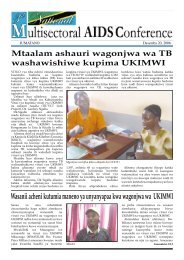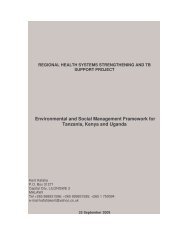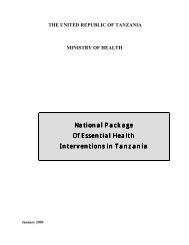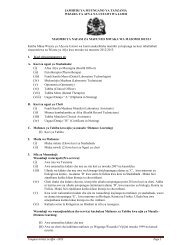Joint External Evaluation of the Health Sector in Tanzania: Draft ...
Joint External Evaluation of the Health Sector in Tanzania: Draft ...
Joint External Evaluation of the Health Sector in Tanzania: Draft ...
You also want an ePaper? Increase the reach of your titles
YUMPU automatically turns print PDFs into web optimized ePapers that Google loves.
The Quality <strong>of</strong> Annual <strong>Health</strong> Statistical Abstracts<br />
Due to reported staff shortages, <strong>the</strong> HMIS team has not had enough time for supervision<br />
<strong>of</strong> data collection at field level and has not been able to produce a health statistical abstract<br />
for every year dur<strong>in</strong>g <strong>the</strong> evaluation period. From 1999 to 2006 only two Abstracts have<br />
been compiled, one cover<strong>in</strong>g 2000/01 (published <strong>in</strong> 2002), <strong>the</strong> o<strong>the</strong>r cover<strong>in</strong>g 2004/05<br />
(published <strong>in</strong> 2006). The quality <strong>of</strong> <strong>the</strong> abstracts has clearly improved over time. The most<br />
recent <strong>in</strong>cludes a narrative description, comparisons and analysis, where <strong>the</strong> previous one<br />
only conta<strong>in</strong>ed tables.<br />
Completeness and Reliability<br />
Despite improvements <strong>the</strong>re is a persistent issue with <strong>the</strong> completeness <strong>of</strong> HMIS data<br />
submitted to <strong>the</strong> <strong>Health</strong> Information and Research Section (HIRS) at MOHSW. The ma<strong>in</strong><br />
problem seems to be that many facilities fail to provide data on time, lead<strong>in</strong>g to large gaps<br />
<strong>in</strong> <strong>in</strong>formation and limitations <strong>in</strong> <strong>the</strong> result<strong>in</strong>g analysis.<br />
Reasons mentioned for this delay <strong>in</strong>clude: time constra<strong>in</strong>ts at <strong>the</strong> HF hamper<strong>in</strong>g prompt<br />
fill<strong>in</strong>g <strong>of</strong> forms, lack <strong>of</strong> IT facilities and/or IT experience at <strong>the</strong> district level (although<br />
s<strong>of</strong>tware for data analysis and report<strong>in</strong>g exists), and non-functional RHMTs, delay<strong>in</strong>g data<br />
checks and forward<strong>in</strong>g to <strong>the</strong> MOHSW. If CHMTs and RHMTs had access to electronic<br />
mail, <strong>the</strong> electronic forward<strong>in</strong>g <strong>of</strong> data could no doubt speed <strong>the</strong> process greatly.<br />
On <strong>the</strong> o<strong>the</strong>r hand, reviews <strong>of</strong> HMIS books at facilities level and discussions with health<br />
workers <strong>in</strong>dicate that <strong>the</strong> HMIS system has become more understandable and easier to use<br />
over time. This more positive view seems to be related to understand<strong>in</strong>g <strong>the</strong> importance <strong>of</strong><br />
data collection and <strong>the</strong> ability to analyse and utilise it. Still, HMIS focal persons compla<strong>in</strong><br />
about <strong>the</strong> time spent on correct<strong>in</strong>g mistakes due to lack <strong>of</strong> both tra<strong>in</strong><strong>in</strong>g <strong>of</strong> new HF staff<br />
and refresher tra<strong>in</strong><strong>in</strong>g for exist<strong>in</strong>g staff as well as <strong>in</strong>sufficient supportive supervision <strong>in</strong><br />
some districts.<br />
Where <strong>the</strong> focal person is active, all staff has been properly tra<strong>in</strong>ed, and supportive<br />
supervision and regular meet<strong>in</strong>gs to discuss data with <strong>the</strong> <strong>in</strong> charges <strong>of</strong> HFs take place, <strong>the</strong><br />
quality <strong>of</strong> data and utilisation can improve. In Mwanza for example <strong>the</strong> completion rate <strong>of</strong><br />
HMIS reports has <strong>in</strong>creased from 60-70 % <strong>in</strong> <strong>the</strong> 1990’s to 90 % at present.<br />
So despite its ongo<strong>in</strong>g shortcom<strong>in</strong>gs, <strong>the</strong>re is evidence that <strong>the</strong> HMIS has been<br />
streng<strong>the</strong>ned dur<strong>in</strong>g <strong>the</strong> evaluation period and that it is understood and used at health<br />
facilities <strong>in</strong>clud<strong>in</strong>g dispensaries, health centres, and district and regional hospitals.<br />
Analysis <strong>of</strong> Data and Utilisation <strong>of</strong> Information<br />
All districts superficially use <strong>the</strong> HMIS data for <strong>the</strong> CCHP, but <strong>the</strong> collected <strong>in</strong>formation is<br />
largely forwarded without <strong>in</strong>-depth analysis at <strong>the</strong> lower level. The district self-assessments<br />
found that only five out <strong>of</strong> sixteen districts claim that <strong>the</strong> HMIS enhances plann<strong>in</strong>g while<br />
six out <strong>of</strong> sixteen claim that it facilitates drug procurement.<br />
Based on <strong>in</strong>terviews <strong>in</strong> <strong>the</strong> districts, one likely reason for lack <strong>of</strong> data analysis and utilisation<br />
<strong>of</strong> <strong>in</strong>formation is that <strong>the</strong> focal person and o<strong>the</strong>r CHMT members, <strong>in</strong>clud<strong>in</strong>g <strong>the</strong> DMOs,<br />
do not have sufficient expertise to optimally benefit from <strong>the</strong> system.<br />
50







